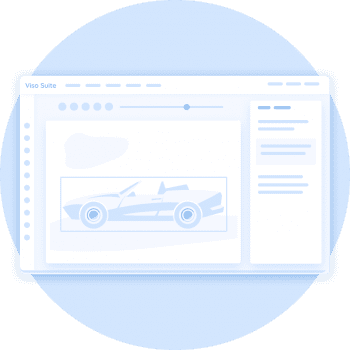
Image Annotation is an important part of computer vision, to create image datasets that can be used as the ground truth to train AI models. As a complete end-to-end computer vision platform, Viso Suite provides enterprise-grade Image Annotation environments directly from within the Viso workspace.
Team members who joined the workspace can directly access the Image Annotation tools and create or maintain datasets for computer vision models.
End-to-end image annotation
Since Viso Suite is a complete end-to-end solution for AI vision, you won’t end up needing additional tools and services to collect video data, train AI models, build applications using them, and deploy them safely to a fleet of connected devices. Viso Suite also supports cutting-edge tools such as semi-automated labeling and automated tagging with Deep Learning.
Import data for video annotation
The creation of high-quality datasets for computer vision requires optimal data. Generating useful video data is a highly important task to ensure the image annotations can be used to train an accurate AI algorithm. Viso Suite lets you use the same cameras for data collection and AI inferencing (to run the application). As a result, you achieve much better results with significantly smaller datasets.
Hence, you can generate video data directly with Viso Suite and import the videos to the image annotation environments or you can import existing video data or annotated datasets. The typical MLOps process requires constant retraining and model optimization to improve the accuracy of computer vision models managed in Viso Suite.
Keep your data safe
With Viso Suite, you avoid exposing your valuable image and video data to uncontrollable risks. Fully integrated with Viso tools for data collection, model training, and application development, your data never leaves your workspace.
Using Viso, you can avoid transferring visual data or datasets to third-party tools and clouds where you can’t control who accesses them. All your data is encrypted and protected with Viso zero-trust security, authentication management, and access control.
And if you need external teams to annotate data for you, you stay in control. Viso provides the option to invite guest users with temporary, restricted, and controlled access to annotate images directly from within the Viso Workspace.
Image annotation for teams
Bring your teams together to collaborate and label data more efficiently, using a broad palette of annotation tools. Either your in-house team or external teams can safely annotate image data with Viso Suite. The enterprise-grade user and access management make sure you always keep your data secure and private.
External image annotation service provider
As your projects and solutions get more complex and extensive, you may need external help and have external users provide image annotation as a service. Since most businesses can’t share sensitive image data or upload it to an external cloud, you can decide to invite external team members to access Viso Suite to provide their services within the Viso Workspace.
While you have full control to limit access only to the image annotation environment, you can also enforce SSO, strong passwords, and audit who and when accessed your Viso workspace. It’s also very easy to fully terminate the access of external image annotation service providers by changing their user roles or removing them from the workspace.
General image annotation platform
The end-to-end image annotation capabilities provide a powerful workspace for professional teams to create high-quality datasets for computer vision training. The most important features are further detailed in the chapters below.
- Bounding box interpolation between key frames
- Automatic annotation with deep learning models
- Action shortcuts
- Shape grouping
- Analytics monitoring
- Basic/advanced usage modes
Image annotation shape types
Viso supports a wide range of shape types that cover the full range of computer vision use cases.
- 2D bounding boxes, rectangle
- 3D object annotation, cuboids
- Polylines, lines, and splines
- Point annotation, ellipses
- Keypoint, landmarks, keypoint naming
- Image classification, image captioning
- Semantic segmentation
- Background/foreground layering, occlusion
- Attribute annotation, annotation with tags
Video annotation features
The image labeling capabilities are optimized for video annotation.
- Video keyframes, sequences
- Video annotation timeline, variable playback speed
- Automatic object tracking across frames, movement tracking
- Object codification, object ID
- Video FPS limiting, frame skipping
- SD, HD, or Ultra-HD 4K videos
- Different camera sources (IP, CCTV, GoPro, Drones)
Semi-automatic and automatic labeling
The installation of serverless functions is supported, for deep learning for automatic labeling, and semi-automatic image annotation. Depending on the DL function, CPU and GPU are supported for different usage levels. The functions include:
- Object detectors, interactors
- Deep extreme cut
- Feature backpropagating refinement scheme
- High-Resolution Net
- Inside-Outside-Guidance
- Polygon generation with Mask RCNN and Faster RCNN
- Deep Learning-based Trackers
Supported annotation formats
All of the most popular image annotation formats are supported, including the following list.
- CVAT for images and CVAT for video
- MS COCO Object Detection
- PASCAL VOC and segmentation masks
- YOLO
- Datumaro
- LabelMe
- TFRecord
- MOT, MOTS,
- Tensorflow Object Detection API
- ImageNet
- CamVid
- WIDER Face
- VGGFace2
- Market-1501
- ICDAR13/15
- Open Images
- Cityscapes
- KITTI
- LFW